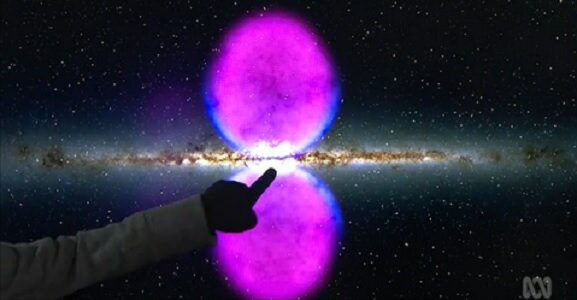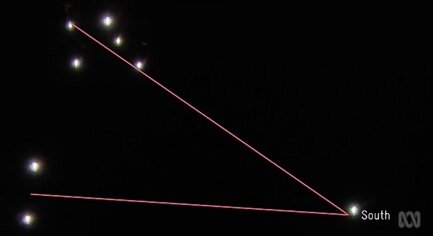Last updated April 21, 2017 at 3:18 pm
Julia Zemiro and Brian Cox hosted the first episode of Stargazing Live, a three-night live program all about the universe. This first episode was all about our home galaxy, the Milky Way.
Let’s look at some of the highlights.
Australia has a unique view of the Milky Way
When we look at the Milky Way we’re looking at something pretty remarkable – we’re looking at a galaxy, from within it. And in Australia, we look directly into the heart of it from a distance of 26,000 light years.
100-200 billion stars make up our galaxy, and a good number of those are thought to have planets orbiting.
While we don’t know exactly what the Milky Way looks like as we’ve never seen it from the outside, we can make some assumptions based on other galaxies, such as our nearest neighbour the Andromeda Galaxy. It too is a spiral galaxy with a central glowing core, but is much larger – at least twice the number of stars (or possibly even more – up to a trillion).
Based on that the show created this fairy light representation (we all secretly want one at home) of what the Milky Way could look like from outside.

We learnt that the reason we can look into the heart of the Milky Way, when the northern hemisphere cannot, is due to the tilt of the Earth in respect to the galaxy. Earth is slightly askew compared to the plane of the galaxy, meaning the southern hemisphere is tilted towards the centre of the galaxy, and the northern hemisphere away, meaning they will never see the same sky as us.
At the centre of our galaxy is a supermassive black hole
Supermassive black holes lie at the hearts of galaxies, including our own. We know this by watching a cluster of stars orbit the centre of our universe. Their orbits revealed they were passing around something very small and incredibly dense with a mass about 4 million times that of our sun – a black hole. The trouble is we can’t see it.
Our supermassive black hole is also a bit weird in that it doesn’t seem to have any of the radiation spewing from it that we see from other black holes. This radiation is normally caused by dust and gas falling into the hole and being “eaten”. The lack of radiation would suggest that’s not happening at our galactic centre, meaning our black hole is quite dormant and peaceful.
But what would happen if something did fall into the hole? We thought we’d get the chance to watch in 2011 as a gas cloud approached the black hole, however in a galactic-sized let down, the cloud sailed straight past apparently unaffected. NASA scientists continued observing the black hole anyway, using the Chandra X-Ray telescope, and 2 months after the predicted collision, they saw two bright bursts of radiation. Astronomers still aren’t sure whether the bursts were linked to the gas cloud or were something else.
Luckily, next year astronomers get to do it all again as a star is currently orbiting the black hole. As the two begin to interact we may find out things we never expected.
Keen to hear results of massive star (15X larger than our Sun) passing by a black hole next year! To study nature of gravity! #StargazingABC
— Aust Science Channel (@RiAus) April 4, 2017
6 million years ago our super massive black hole had quite an appetite
Dr Lisa Harvey-Smith studies black holes and explained that millions of years ago the supermassive black hole in the centre of the Milky Way ate 100,000 suns. After its mega meal, it essentially burped out giant bubbles which still exist around the centre of the Milky Way.

Indigenous star stories tell the same stories as modern astronomy, but differently
If you ever get the chance to listen to Indigenous star stories, do it because they’re absolutely fascinating. On Stargazing Live we heard from Elder Ghillar Michael Anderson of the Euahlayi people in NSW as he told the story of the emu in the sky.
The Milky Way, or Wurrum-Boorrool, is a river of stars through the sky, spilling out at the Coal Sack Nebula, or the head of the emu named Garwaar-ghoo. The emu is a sacred spirit visible in the sky from April to August, and when it leaves the sky it comes and travels on the Earth either in the water as a water spirit, or on land as the black emu.
Indigenous Australians might be the world’s first astronomers, having looked at and studied the sky for tens of thousands of years. They also use the sky to describe how people came to Earth, and their stories are fascinating interpretations of what they have observed.
One of the brightest stars in the sky, Alpha Centauri, is a triple star system
When we look at the brightest stars in our sky with a naked eye we only see two sunlight stars, Alpha and Beta Centauri, but there is also third called Proxima Centauri. And just recently it was found that there is a planet orbiting this third red dwarf star called Proxima b.
If you were to visit (taking 20 years using an untested experimental spacecraft) things might be a little dull. The light on Proxima b would be only 2/3 as bright as the light on Earth thanks to its dim red dwarf star. However, with the amount of radiation there could be intense auroras, which would be quite the sight! For now, it’s still unknown if it has water or an atmosphere habitable for humans.
- RELATED VIDEO: Brew Ha Ha – Proxima b, back in August 2016, when Proxima b was discovered, we took a closer look at our new neighbour.
You can use the stars to find south
Greg Quicke (more on this legend below) showed us how to triangulate between the two brightest stars in the sky (Alpha and Beta Centauri, at the bottom of the image) and the Southern Cross (at the top). The point where they meet is south.

You can help find a new planet!
The mysterious and as yet unseen Planet 9 of our solar system is being hunted, and you could take part.
Using data from the Keppler telescope, citizen scientists can search data looking for changes in light from stars. If you find a dip in light coming from stars it could suggest a planet transiting in front of the star and blocking light. If you find dips that no one has found before you may have found a brand new exoplanet.
To take part, head to Exoplanetexplorers.org
There is also a similar Australian project run by the Australian National University searching for Planet 9, which has the backing of our own Nobel Laureate Brian Schmidt. Using data from the Skymapper telescope, we can search images and identify the tell tale signatures of planets. To take part, check out planet9search.org
Space Gandalf is amazing
Last week the UK went crazy over a uniquely Australian astronomer named Greg Quicke, and this week it was his own country’s turn. From Broome, Greg has spent a large amount of his life in a swag in the Kimberleys watching the stars, which he describes as old friends. He probably has also spent years observing the sky from Middle Earth.
He showed us how the sky we see is the other way up compared to the northern hemisphere, but he likes to claim we look at it the right way up.
Greg will be a regular contributor to Stargazing Live, which is great as we get to gaze upon his stellar beard. He’s the astronomy teacher you always wish you had, you can’t help but get wrapped up in his excitement about what he sees. Plus watching that beard in the wind is a sight to behold.
Catch up on the highlights from the second episode “Planets” HERE , and the third episode “Aliens” HERE
Images from the ABC
Follow us on Facebook, Twitter and Instagram to get all the latest science.





























































































































































































































































































































































































































































































